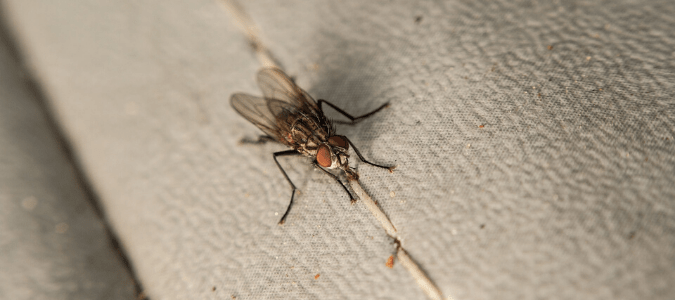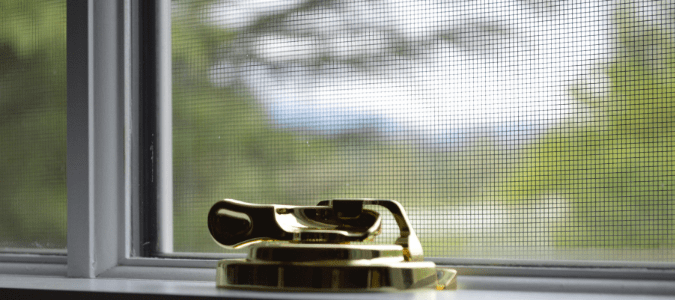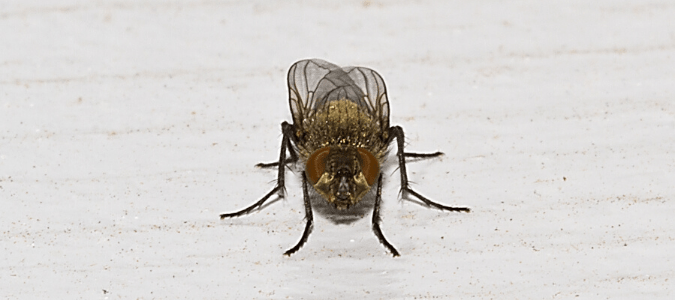
What started with just one or two big flies in your house started to become a pattern, which led you to wonder if you had some kind of a larger pest problem. Swatting away at these flies soon became a constant battle and a big headache. What brought these flies into your house, and what can you do now to both get rid of them for good and prevent this from happening again?
Unfortunately, during the warmer months, it’s not uncommon to feel as if keeping flies out of your home is a constant battle that you’re losing. There are several different types of flies that people routinely find in their homes, and many of them are there simply because they’re opportunistic—meaning, they come in from outdoors when they get the chance, in search of food and shelter. They can slip through even if you simply open the door briefly to walk in or out, and they’ll certainly come inside if you prop the door open. They can also use their relatively small size to easily slip through small gaps in window and door screens or cracks in the walls.
If you’re dealing specifically with big flies in your house, as opposed to smaller flies such as fruit flies or gnats, it’s likely that you’re dealing with either the common house fly or an even larger variety of fly, such as flesh flies, cluster flies or blowflies. Let’s take a look at each of these different types of flies so you can determine which one is invading your home, and learn what you can do to keep these bothersome insects out of your living space.
Despite having a name that would suggest otherwise, house flies are actually most commonly found outdoors. About a quarter-inch long and light gray to dark grayish-black in color, house flies sometimes have stripes down their backs. While they don’t bite humans, they are definitely annoying; when you find them inside, they are typically buzzing around, often lighting on food while you’re trying to eat, and potentially spreading germs everywhere they touch. Beyond being a nuisance, they can carry and spread diseases.
Flesh flies look a lot like house flies, except larger. They are less likely than house flies to be vectors of disease, but they are no less annoying. Since both of these fly species spend time outdoors on unsanitary things like pet feces and garbage, both can transfer tiny particles of these items to anything they touch inside your home, creating unsanitary conditions indoors. Flesh flies are also attracted to dead animal flesh, so their presence inside a home could indicate a dead rodent or other animal that is trapped somewhere indoors, such as in the attic or inside a wall void.
When comparing cluster flies and house flies, you should know that cluster flies are a bit larger and darker in color, and their bodies may have a checkered appearance. Like flesh flies, cluster flies aren’t known to carry diseases. Unlike house flies, which are more prevalent during summer months, cluster flies often head indoors during the colder months of fall and winter. Since they are attracted to warmth and light, they are often found congregating together on windows or other light sources. Fortunately, they don’t reproduce indoors; female cluster flies lay their eggs outside in late summer or early fall.
Blowflies are far more vibrantly colored than house flies, and like flesh flies, they are also potential indicators of other problems. With metallic blue or green bodies, blowflies are a bit larger in size than house flies. Blowflies have been known to spread infections and diseases, including eye infections, dysentery and other illnesses. The biggest issue with blowflies is that, like flesh flies, they are attracted to dead animals. If you find blowflies indoors in significant numbers, it might indicate a problem similar to when you see flesh flies: that a dead animal has gotten trapped and died in some interior space, such as inside a wall, chimney, crawlspace or in the attic.
While most flies typically live and breed outside, some, such as house flies, have been known to lay eggs inside people’s homes. These eggs hatch into larvae and eventually into adult flies if they aren’t eliminated. Blowfly larvae have also been known to crawl into people’s homes, either from the outdoors or from inside a wall or other interior space. Transitions from egg to larvae, and then pupae to adult flies can happen quickly. During the warmer months of summer, for example, the house fly life cycle can span as little as a week, from newly laid egg to adult fly, and flies can live as long as two months.
If house flies lay eggs in your home, it will likely be in a warm, moist, dark place, such as inside an indoor compost bin or garbage can. The first sign that might indicate that flies are breeding inside your home is a rather disgusting one: the presence of maggots, which are actually just fly larvae. If you spot what look like thin, whitish-yellow or light-brownish worms inside your home that are about a quarter-inch to a half-inch long and a few millimeters wide, these may be fly larvae, which would indicate that flies are reproducing somewhere indoors.
Obviously, it’s easier to eliminate flies from your home when there are fewer present, before they have the chance to reproduce and increase their numbers. It’s easier still to prevent them from coming in than to get rid of them once they’ve taken up residence. So what can you do to keep flies out of your home? Here are several preventative measures that can help:
- Keep your yard clear of pet feces, which attracts flies. Check your lawn daily and put any waste into your outside trash can, if possible.
- Keep all garbage, both indoors and outside, in bins with tightly fitting lids, so flies can’t get inside.
- Repair any tears or gaps in screened doors and windows.
- Close off any gaps or other points of entry that wild rodents and other animals might use to access the interior of your home, garage or attic.
- Keep doors and windows closed as much as possible, and use the AC during warmer months.
- If you keep a compost bucket inside, make sure it has a tightly fitting lid and empty it regularly.
- If you have cats that use an indoor litter box, clean and refresh it regularly.
- If you store recyclable items indoors for any period of time before taking them outside, make sure they are well rinsed, and preferably stored in a bin with a tightly fitting lid.
- Keep indoor drains clear of water, food debris and buildup.
- Keep your home clean, especially in the kitchen. Don’t leave food out uncovered, and wipe up crumbs and spills as they occur.
If you have just one or two flies indoors, a fly swatter may be all you need to get rid of them. Any more than that, however, and it may be necessary to implement the above preventative measures along with additional elimination strategies, especially when you take into account how long flies live. Contacting a pest control specialist can also save you time and frustration, as these professionals can control your pest problem quickly and completely while addressing any related issues such as the presence of wildlife, alive or dead, in or around the home.

Why Do I Have So Many Flies in My House?
Homeowners can understandably feel a sense of disgust anytime there is more than one fly inside at a time. The most common question when this happens is: Why? While there could be several different explanations, the two most common reasons why people have flies indoors have to do with access and sanitation.
First, many people don’t realize that they aren’t properly sealing off the outdoors; they might prop open their doors to let in the breeze or fail to fix gaps in their window screens, both of which allow opportunistic flies to slip inside. Second, many people might not consider the need for increased cleanliness inside, to limit flies’ access to the food they seek when they do come indoors.
Flies are after two things when they come into your home: food and shelter. If you are struggling with annoying flies invading your home, you’ll have to cut off their access to both of these basic needs. Cutting off their access to shelter essentially means figuring out where the flies are entering your home, whether it’s through cracks in the walls, tears in the screens covering your windows and doors or windows or doors that are propped open for too long. Once you know where the flies are coming from, you can take steps to close off and protect those entry points to keep the pests outdoors.
Cutting off flies’ access to food inside your home most often involves keeping a clean kitchen—wiping up spills and crumbs, washing dishes frequently and storing food in airtight containers. But some flies, such as flesh flies and blowflies, feed on and reproduce in the carcasses of dead animals. If you have a rodent control problem in your home, attic or garage, these flies could be a symptom of that issue, regardless of the cleanliness of the rest of your home.
It’s also important to note that you might have lots of flies in your house simply because there are too many flies outside, in your yard. This is often the case for people with pets, as many types of flies are attracted to dog and cat feces. Keeping your yard clear of pet droppings will cut down on the overall fly population around your home, which will in turn reduce the number of flies that come indoors. If this seems to be a recurring problem, no matter what you try, you may be better served by contacting an experienced professional who can deliver effective pest control treatments to eliminate flies in your home and also advise you on steps to take to prevent flies and other unwanted insects from coming indoors in the future.

How to Get Rid of Cluster Flies
If you’re wondering how to get rid of cluster flies specifically, the first thing to address is entry points the flies are using to get indoors. In fact, this is true for most types of flies that you might find inside your home: Find where they are getting inside and close it off, and you’ll have gone a long way toward solving your fly problem. One thing to keep in mind is that cluster flies are more likely to come indoors during the colder months of the year, while house flies and other types of flies are more likely to proliferate and come indoors during the summer months.
Whether you’re dealing with cluster flies, house flies or even a type of black fly inside your home, contacting a pest control specialist is often the quickest, easiest and most efficient way to resolve your pest problem. Pest control professionals are experienced in handling all types of pest infestations and have knowledge about any type of fly or insect that might be invading your living space. Licensed technicians can resolve the issue quickly and thoroughly, and equip you with the knowledge, tools and strategies you need to avoid another infestation in the future.
ABC Can Handle Any Type of Pest Problem
Swatting at big flies and feeling like you’re getting nowhere can be discouraging. Additionally, dealing with a fly problem can feel embarrassing. If you feel like you’re losing the battle against flies, contact ABC Home & Commercial Services. We will be able to get to the root of your fly problem and then implement a thorough pest control solution to you won’t have to worry about sharing your space with flies.